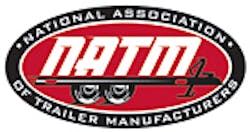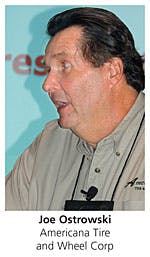NATM convention coverage: Chemical makeup of a tire is specified by manufacturer and greatly affects performance, regardless of application
JOE Ostrowski, sales manager for Americana Tire and Wheel Corp, believes that tires are a very critical element for the performance of a trailer.
“I always say, ‘If your feet hurt, you don't feel good,’” he said. “Well, our tires are your feet.”
He said the items being mixed are the critical elements for a tire. In the mixing, chemicals are weighed in proper proportions in what is mostly a manual process, while carbon black and oils are weighed automatically.
“The chemical makeup of a tire is specified by the manufacturer and greatly affects the performance, no matter the application,” he said. “The compound pretty much dictates how a tire is going to perform.”
A tire consists of natural rubber, polymer, carbon black, oils, additives, and curatives.
“Every rubber compound ever made contains natural rubber,” he said. “Normally, the higher the content of natural rubber, the better the performance. It's grown within plus or minus 12 degrees latitude of the equator. That's the only place that can effectively plant and harvest rubber trees. It's seven years from planting until harvesting the latex.
Manufacturing a tire is a multi-step process of the inner liner being laid onto the tire, body ply or plies, sidewalls, beads, and tread rubber.
“Tires are a blend of different compounds,” he said. “No tire is made with the same compound whatsoever. There is a mix of compounds on any tire. A trailer tire is not built for traction. Or turning. The side walls are much heavier than on a passenger car tire.”
Ostrowski said the typical travel time from Taiwan or China is 30 days. Containers are cleared through Customs then off-loaded by hand.
He said it's not a good idea to use a passenger car tire on a trailer.
“Like people, some are leaders and some are followers, and the same is true for a tire,” he said. “A passenger vehicle is the leader, so in passenger tires, traction is the key focus in the design. The design allows turns around corners and braking. They're designed for ride comfort, which is achieved by allowing sidewalls to flex.
“Trailer tires are designed to carry loads and have a heavier sidewall. They're not designed to be leader. They're designed to be the follower.
“Sidewall flexing is a negative and the major cause of swaying. Passenger car tires on a trailer can accentuate the problem. It's a dangerous thing. Stiffer sidewalls are found on ST tires and help reduce swaying. ST tires are built to withstand the stress and dynamics of towing. ST tires are constructed with heavier duty materials, making them tougher than passenger car tires.”
“Even if you kept it at that load, the sidewall flexion would still make it a dangerous option,” he said. “You have significant swaying issues if you use a passenger-car tire on a trailer application.”
He said the DOT code is the DNA of a tire. It's required on all tires sold in the US and provides traceability to where the tire came from and who manufactured it.
“On a Loadstar series tire, the DOT code ‘K3’ signifies a Kenda brand from Taiwan manufactured in the 25th week of 2011,” he said.
The world of wheels
Denton said Dexter makes wheels from scratch, using steel coils that weigh 5000-8000 pounds each, slit to width, each tagged.
“We start with coils in the decoiler,” he said. “We sheer a strip of steel, then coil it, wrap that hoop and weld it, and do a weld operation. After the weld hoop, we flare the edges to start it through the rolling process. Then it goes through a three-stage roller operation. You can only form steel at 15 degrees at a time of multiple-bend operations to get to the final wheel stage.
“There are three roller stations. We build the rim slightly smaller. At the end, we have a die that expands the wheel out to get the final dimension. You have to hold that rim-diameter dimension so the rim diameter and tire diameter are tight — it doesn't leak but you can still mount on it. An automatic punch brake punches holes in it.
“Automatic welders do four rims at the same time. Some wheels are welded all the way around, depending on the load capacity of the wheels. After welding, they go into a wash. You have chemicals on the wheel, so it goes to a station wash bay, and is washed with water or different chemicals.
“We e-coat all wheels. It's a positive/negative charge with a two-minute immersion time. After they're e-coated and dry, we paint them. Internet sales people want the wheel painted on both sides.
“After the wheels are powdered, they go through the oven. We run 400 wheels an hour through the powder coater. Wheels come down and are tagged with a sticker and stacked in pallets. They are all marked, stretched, wrapped, and palletized.
“We do check wheels with an online system with radial and lateral run-out. Trailer wheels are typically centered wheels. We do get some with half-inch offset. If you do change this offset, we have to go out and do all testing for DOT.
“Offsets are negative and positive. Positive means you move the wheel and tire closer to the trailer frame. Typically old horse trailers and car carriers were positive offset.
“All wheels have to be marked by who made them. The country of origin, DOT number, and size, and they're stamped ‘trailer use only’ with the month, date, year, and shift it's made on, coil number, and the vendor the steel comes from.”
About the Author
Rick Weber
Associate Editor
Rick Weber has been an associate editor for Trailer/Body Builders since February 2000. A national award-winning sportswriter, he covered the Miami Dolphins for the Fort Myers News-Press following service with publications in California and Australia. He is a graduate of Penn State University.



